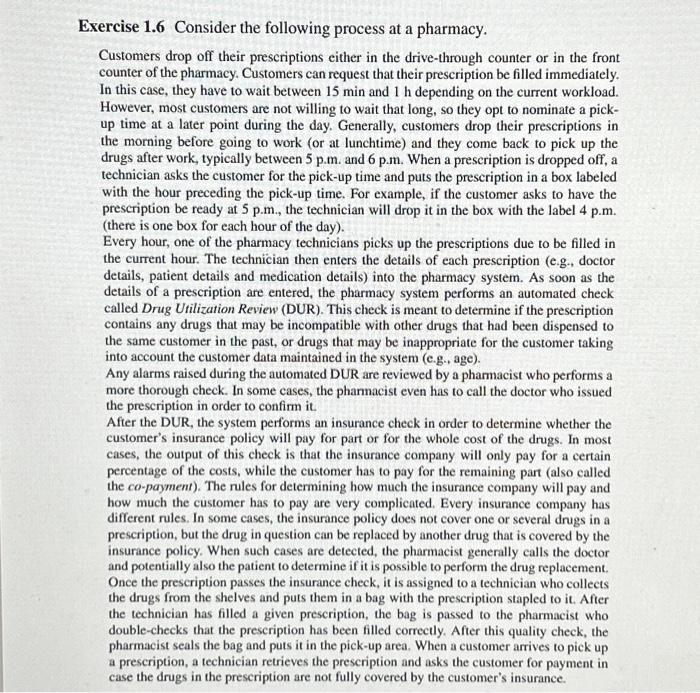xercise 1.6 Consider the following process at a pharmacy. Customers drop off their prescriptions either in the drive-through counter or in the front counter of the pharmacy. Customers can request that their prescription be filled immediately. In this case, they have to wait between 15min and 1h depending on the current workload. However, most customers are not willing to wait that long, so they opt to nominate a pickup time at a later point during the day. Generally, customers drop their prescriptions in the morning before going to work (or at lunchtime) and they come back to pick up the drugs after work, typically between 5 p.m. and 6 p.m. When a prescription is dropped off, a technician asks the customer for the pick-up time and puts the prescription in a box labeled with the hour preceding the pick-up time. For example, if the customer asks to have the prescription be ready at 5 p.m., the technician will drop it in the box with the label 4 p.m. (there is one box for each hour of the day). Every hour, one of the pharmacy technicians picks up the prescriptions due to be filled in the current hour. The technician then enters the details of each prescription (e.g., doctor details, patient details and medication details) into the pharmacy system. As soon as the details of a prescription are entered, the pharmacy system performs an automated check called Drug Utilization Review (DUR). This check is meant to determine if the prescription contains any drugs that may be incompatible with other drugs that had been dispensed to the same customer in the past, or drugs that may be inappropriate for the customer taking into account the customer data maintained in the system (c.g., age). Any alarms raised during the automated DUR are reviewed by a pharmacist who performs a more thorough check. In some cases, the pharmacist even has to call the doctor who issued the prescription in order to confirm it. After the DUR, the system performs an insurance check in order to determine whether the customer's insurance policy will pay for part or for the whole cost of the drugs. In most cases, the output of this check is that the insurance company will only pay for a certain percentage of the costs, while the customer has to pay for the remaining part (also called the co-payment). The rules for determining how much the insurance company will pay and how much the customer has to pay are very complicated. Every insurance company has different rules. In some cases, the insurance policy does not cover one or several drugs in a prescription, but the drug in question can be replaced by another drug that is covered by the insurance policy. When such cases are detected, the pharmacist generally calls the doctor and potentially also the patient to determine if it is possible to perform the drug replacement. Once the prescription passes the insurance check, it is assigned to a technician who collects the drugs from the shelves and puts them in a bag with the prescription stapled to it. After the technician has filled a given prescription, the bag is passed to the pharmacist who double-checks that the prescription has been filled correctly. After this quality check, the pharmacist seals the bag and puts it in the pick-up area. When a customer arrives to pick up a prescription, a technician retrieves the prescription and asks the customer for payment in case the drugs in the prescription are not fully covered by the customer's insurance. With respect to the above process, consider the following questions: 1. What type of process is the above one: order-to-cash, procure-to-pay, applicationto-approval, or issue-to-resolution? 2. Who are the actors in this process? 3. Who are the customers? 4. What are the tasks of this process? 5. What value does the process deliver to its customers








